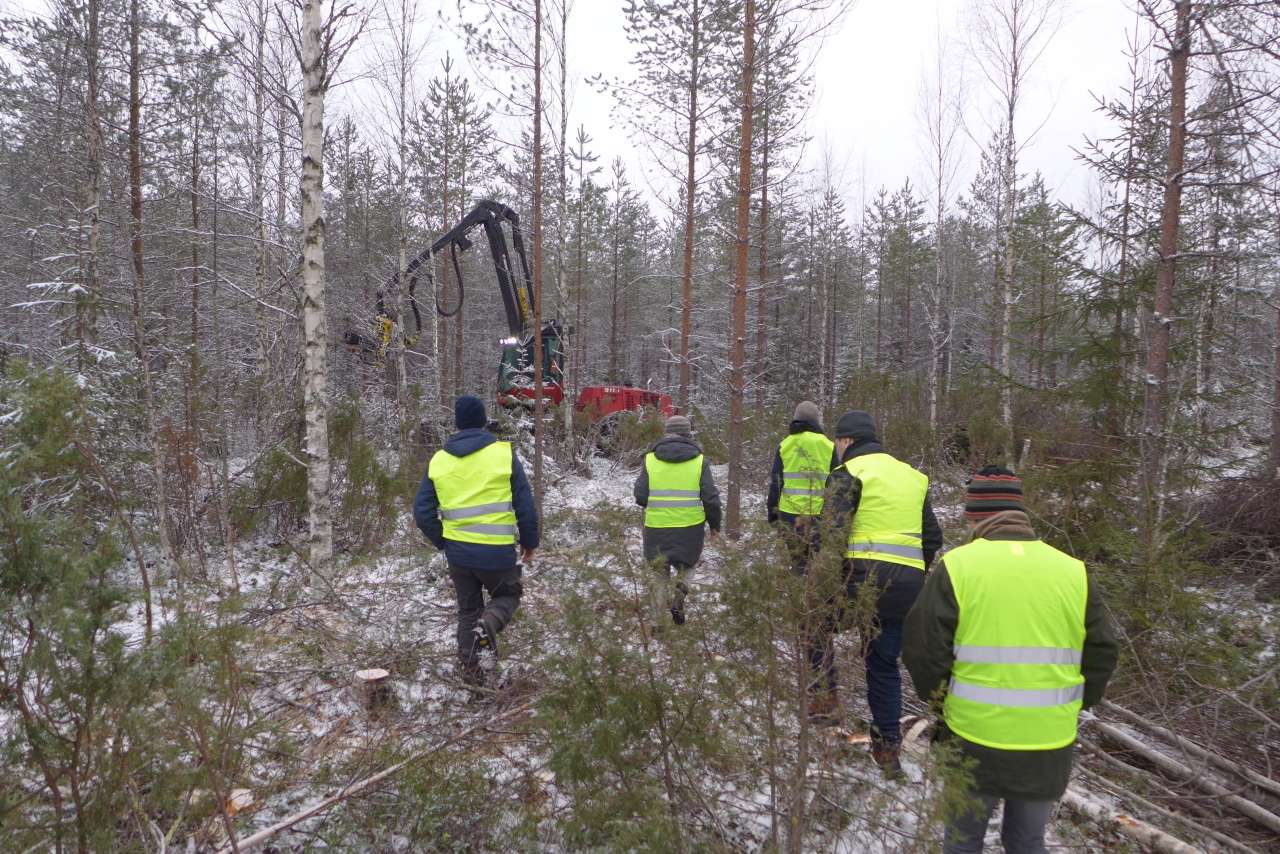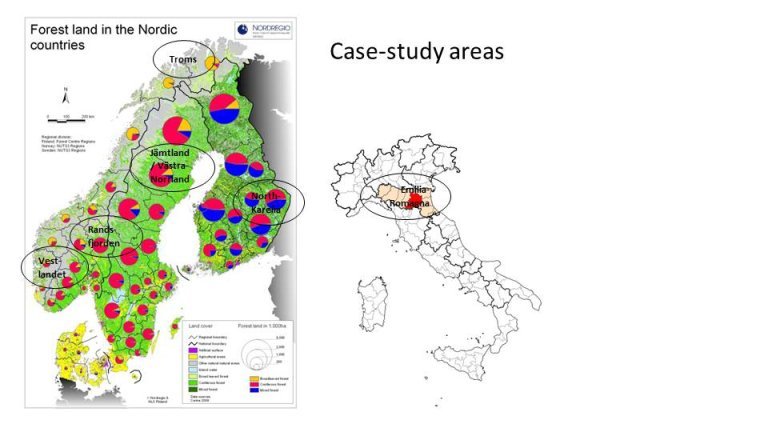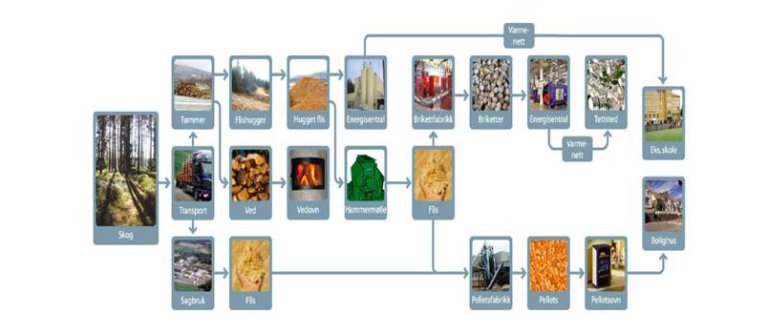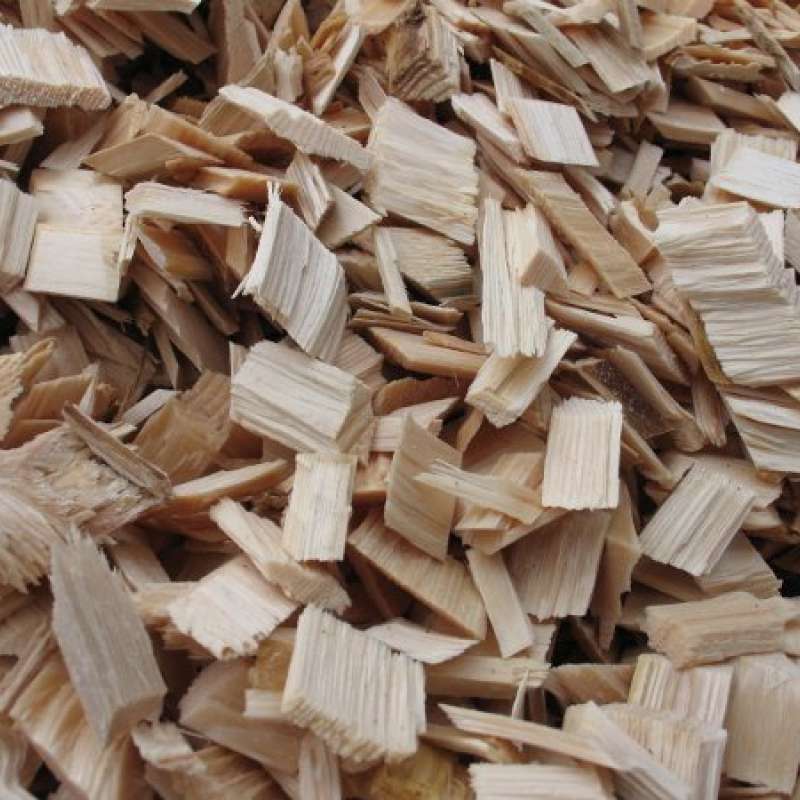WP23

Data gathering, GRIP-facilitation, evaluation of outcomes and policy instrumentation
This WP will set up case-study areas in Norway, Sweden, Finland and Italy. It will facilitate GRIPs, gather data from the GRIP-processes, and gather environmental and operational data from existing trial plots.
We will use the case studies to:
- identify good practices at regional level to develop the local potential for bioenergy
- analyse policies and institutions that affect bioenergy development
- identify potential effects of biomass removal on ecosystem services.
The case will generate an integrated narrative of how bioenergy works in selected regions, i.e. identify drivers, barriers, enabling conditions, and TBL effects.
Further this WP will evaluate outcomes and policy instrumentation based on the data collection. We will test H1 by generating data on the bioenergy production initiated by the GRIPs. Effects on bioenergy production will be estimated by up-scaling the results and calculating the effect on how the application of the GRIP approach can facilitate the fulfilment of the national targets.
For H2 we use survey methodology and comparative policy analysis to generate data about the different types of innovation gathered through interviews and surveys among the GRIP participants.
For H3 we use comparative case-study methodology of the GRIPs’ internal learning processes, power structures, conflict handling, and ability to spur bioenergy initiatives.
For H4 we base the evaluation on the environmental indicators in WP2, which will serve as a framework for evaluating the cases. This includes knowledge of how to optimise use of the forest landscape for multiple functions, both economic and non-economic, including early-stage clarification of important trade-offs and enabling knowledge-based management and decision making.
In addition, work will be done in identifying and quantifying the biomass resources at a landscape level, calculating weighted mean transport distance and mode, considering conversion technologies and their efficiencies, energy distribution and the substitution effect of that energy.

Contacts




Bjørn Egil Flø
Research Scientist
-
Division of Food Production and Society
(+47) 951 15 617 bjorn.flo@nibio.no Office Location: Trondheim
WP23a: Identify case study areas in Norway, Sweden, Finland and Italy

WP23b: Map and interview stakeholders in Norway, Sweden, Finland and Italy
In this WP we first map the key stakeholders in the case-study areas. As a point of departure we group the stakeholders into four main groups: businesses, public authorities, civil society and knowledge institutions.
The businesses can be foresters, farmers or entrepreneurs that are involved in bioenergy as an economic activity and/or which are important the supply of raw material for bioenergy production. The public authorities being national, regional or local authorities or sector institutions like Innovation Norway and ENOVA facilitating for innovation and activities through instrumentation. The civil society represents the stakeholders mostly using the forests and its products or services for heat, recreation or other. Finally the knowledge institutions may be research, education, advisory services, but also consultancy through businesses may act as knowledge institutions.
We have produced draft reports from areas in Norway, Italy and Finland. Randsfjorden, Vestlandet and Troms areas selected in Norway. We have carried out an extensive number of thorough interviews with stakeholders in the case-areas and gathered other contextual information.
WP23ck - Identification of, monitoring of, and dialogue with GRIPs
TRIBORN focuses on Grounded Innovation Platforms or ‘GRIPS’. An Innovation Platform is a group of (local) actors who voluntarily come together to achieve a certain goal.
The task
In our case, the goal is some aspect of bioenergy, normally forest-based, but not always. Platforms may be formal, informal or somewhere in between, but normally involve meetings and other processes to do things like:
- Share Goals and Objectives and reach a common general objective
- Discuss what is and is not known about the ways of meeting that objective (raw materials, finance, skills, technologies, interests, markets etc)
- Fill knowledge gaps
- Negotiate raw material supplies and contracts; negotiate markets and contracts; negotiate and plan constitution (coop, company, partnership, non-profit, municipal-owned etc) loans, equity, siting, construction etc
- Implement ‘the project'
- On-going learning by doing and feedback loops leading to adjustments, enlargement, etc
- Key junctures (often crises) which trigger joint activity of some kind.
- The processes within the GRIPS. These include, for example, learning processes, conflict-resolution, lobbying beyond the GRIPs, using external expertise, finding new markets, finding new technologies or processes, changing scale of production, etc);
- The outcomes for the GRIPS and for the local economy, society and environment. These include, for example more local value added (incomes-to-locals) and the number of beneficiaries and distribution of benefits and beneficiaries; more and/or better employment (and for gender, ethnic or other groups especially needing work); cheaper energy; safer or more flexible or secure energy; more resilient communities; lower climate gas emissions; improved biodiversity; stronger networks and building social capital; improved community empowerment and resilience; better policy representations, and so on )
- Hadeland has one of the most advanced bioenergy sectors in Norway that is based on local actors. The local politicians and administration has worked together for common bioenergy goals. These goals are mainly related to local business development, but also to environmental considerations. Several local private actors and the forest commons are involved in bioenergy activities. The private actors and the commons have, however, only to a minor extent worked together and shared knowledge. The Energy farm, a national competence center for bioenergy, has been crucial for engaging the local politicians and local farmers and foresters.
- Northern-Land has a well-functioning GRIP for bioenergy. Local foresters, through the local forest owners cooperative has been working together with the local administration and local politicians and the public has been involved through public meetings.
- Voss also has a well-functioning GRIP where several local actors such as local foresters, the local power company and the local waste disposal company have been working together. The public is positive to the bioenergy activity.
Bryden et al. 2015 - ESRS
NESS2015 paper by Bianca
WP23k - Groups Dialogue
This subWP concerns our work with those bioenergy cases identified as GRIPS. The key idea here is participatory research, led by the GRIP, which has a set of problems and objectives, of various kinds, which they agree to work on together. These may be concerned with technology, with synergy (looking for other partners), with costs or prices, with logistics, with markets, with local opposition or conflicts, with regulatory policies, with policies around incentives or in any other area, and they may also be some mix of these issues. The task of the research team is to understand the problems and objectives, which’ GRIPS’ are working on, to understand the learning processes involved, and to help them where possible to reach their objectives and solve their problems, deal with conflicts etc. Beyond this, the research team seeks to understand the outcomes at present, and foreseen as a result of meeting objectives, in terms of TBL and/or HR-TBL.
WP23d - Biofuels
There has been much debate about the carbon neutrality of forest harvesting, i.e. whether it is better from the point of view of carbon sequestration to harvest trees or to let them stand in the forest.
Objective
This is a complex issue, as many factors play a role, such as the spatial and temporal scale considered as well as the use to which the harvested wood is put. In addition, other uses of the forest, such as its importance for rural employment, have to be considered. We will contribute to this debate with (i) a peer-reviewed paper on the effects of intensified biomass harvesting on soil organic carbon and (ii) a newspaper article directly addressing the question.
Results
EU/ETA as well as US policies stimulate biofuels (Bio-diesel and Bio-ethanol) production and import by mandating admixtures in diesel and gasoline, as well as through a range of subsidy regimes. Given current and on-going critiques of the economic, environmental and human impacts of biofuels production based on agricultural feedstocks derived from arable land and or third countries (e.g., Palm Oil), interest in biofuel production from secondary biomass and waste, and from forests, is increasing.
Hypotheses
- The Nordic countries offer significant scope for forest-based biofuels which is being hampered by economic issues (high costs) and policy mis/matches or uncertainty.
- The economic constraints can be overcome by new technological and process innovations currently being developed
- The policy constraints will remain unless it can be shown (a) that the economic constraints can be overcome and (b) the production of forest based biofuels can meet the potentially strict sustainability criteria of the EU.
WP23e - CO2-capture - balancing use of forests for carbon storage and bioenergy
Results
Effective forest governance measures are crucial to ensure sustainable forest management. Sustainability principles and criteria have therefore to be incorporated into policy frameworks and support schemes, as well as management guidelines and certification systems. Although there is great site-to-site variation, science-based and operationally practical management guidelines might be developed with the help of expert judgement. In addition, it is vital that governance measures are accepted by stakeholders. ‘Soft’ governance measures, e.g. management guidelines and certification systems, may often be more adaptable to changes and local conditions, and more inclusive of stakeholder inputs, than legislation, and thus more easily accepted.
Comparisons of management guidelines have been made for countries, states or provinces with boreal and/or temperate forests. Although it is possible to learn from other countries, it is probably rarely advisable simply to copy their guidelines because of local differences. However, comparison of different countries’ guidelines may help to identify broad areas of agreement that should be included, while leaving details to be worked out nationally or even at a more local level. This would increase local empowerment, in accordance with the subsidiarity principle, and also emphasises the importance of training of forest managers.
Although many countries have produced national recommendations and guidelines for biomass extraction to encourage this taking place in agreement with the principles of sustainable forest management, the focus has so far been largely on nutrient management and avoidance of soil damage by compaction or erosion, and there has been little specific focus on soil organic carbon (SOC) stocks. Regarding certification systems, harvesting effects on SOC have until recently not often been explicitly included in Programme for the Endorsement of Forest Certification (PEFC) or Forest Stewardship Council (FSC) certification systems, although some mainly newer standards do include requirements focussing on the forests’ contribution to the C cycle. Aside from strict forest certification systems, there are other certification systems, standards and suggestions for criteria related to bioenergy production, some of which are relevant to preservation of SOC stocks also in forests.
The European Union’s directive on the use of energy from renewable sources (RED) includes a mandatory sustainability scheme for biofuels (defined as liquid or gaseous fuel for transport) and bioliquids. Although it is stated in Point 4 of Article 17 of the RED that biofuels and bioliquids shall not be obtained from land that was continuously forested in January 2008 and is no longer continuously forested, this is in the context of land-use change and thus does not prohibit forest harvesting for bioenergy purposes, which is not considered as land-use change if forest is replanted or allowed to regrow naturally. Other land areas with high SOC stocks, such as wetlands and peatlands, are similarly protected. Furthermore, in the rules for calculating the greenhouse gas impact of biofuels and bioliquids given in the RED’s Annex V, a 20-year period is used for estimation of C stock accumulation, which is clearly far too short a time for forest SOC stocks to accumulate again after harvesting.
The RED was followed by a report on sustainability criteria for the use of solid and gaseous biomass sources in electricity, heating and cooling, recommending the extension of binding EU sustainability criteria for biofuels/bioliquids to solid/gaseous biomass used for electricity and heating/cooling. These recommendations are not mandatory. If in the future liquid or gaseous biofuels are to be prepared from forest biomass on a commercial basis (which will necessarily involve more intensive use of forest biomass), the sustainability criteria given in the RED will apply.
Current governance measures may state that SOC stocks are to be protected during forest operations, but in general little or no direct guidance is given as to how this is to be achieved. Partly this is due to the diverging results from various experiments, which is connected to the complexity of the processes involved, the difficulties associated with measuring the changes, and the number of factors that affect the SOC stock. The currently available information, especially from field studies, does not support firm conclusions about the long-term impact of intensified forest harvesting on SOC stocks in boreal and northern temperate forest ecosystems, which is in any case species-, site- and practice-specific.
Until more knowledge is available, the gap of uncertainty between the scientific results and the need for practically useable management guidelines and clear indicators can only be bridged by expert opinion given to authorities and certification bodies. Properly conducted long-term experiments might be able to clarify the relative importance of different harvesting practices on the SOC stocks, which are the key factors affecting the loss of SOC, and under which conditions the magnitude of the removals becomes critical. Importantly, such experiments would also provide new data for testing of models, thus improving their ability to predict long-term effects of different harvesting methods under varying site conditions and hopefully bridging any gap between modelling results and field observations. Both well-designed new experiments and continuation of existing long-term experiments are therefore very important.
WP23f – Environmental evaluation
Results
For the purpose of environmental evaluation, we consider that foresters working at the local level are most likely to be familiar with guidelines/certification systems such as the Norwegian PEFC standard. Thus, it is these that should form the basis for discussions, especially where a bottom-up approach is being used. Potential questions include:
- What potential environmental impacts do you associate with bioenergy extraction?
- Is a standard or certification system being followed during biomass extraction? If yes, which one: PEFC (Living Forest), FSC, Debio (ecological forestry), others?
- Biodiversity: Has MiS registration been carried out? Are buffer zones being left around surface waters, and if so, how wide are they? Are high stumps and/or dead wood left on-site? Are other measures being carried out to protect biodiversity?
- Soil, water and nutrient management: What measures are taken to minimise nutrient depletion, erosion, soil compaction, rutting etc.?
- Energy efficiency: Are transport and other energy needs during biomass extraction met using fossil fuels?
- Are measures carried out to protect cultural heritage?
- Recreation: Are there any paths or popular destinations for recreation in the area? Has the forest recreational value? Are there any measures in place to preserve recreational potential, and if so, what? Have there been any conflicts between forestry and recreational users in the area – if so, what was the problem? Could particular forest management be used to improve recreational potential – and maybe even encourage tourism in the area (e.g. by opening views to water)?
- Are there any information boards explaining different forestry practices, or about the biodiversity, cultural heritage or landscape in the area?
Team: Tonje, Jørn Frode, Wenche, Wendy, Holger, Hilde, Vegard, Åsa, Emilio
WP23g - Field studies of effects of intensified biomass removal from forests for bioenergy
Ecosystem services are defined as describing the benefits people obtain from ecosystems. These include provisioning services such as food, water, timber, and fibre; regulating services that affect climate, floods, disease, wastes, and water quality; cultural services that provide recreational, aesthetic, and spiritual benefits; and supporting services such as soil formation, photosynthesis, and nutrient cycling.
Objectives
While ecosystem services are the focus of considerable research, the link to the landscape and the application of the findings in decision making are still in need of knowledge development. Multiplicity of ecosystem services entails potential conflicts of interest because economic services may conflict with, for example, biodiversity and recreational services. Arbitration and trade-offs may thus be necessary; use of the forest landscape for bioenergy must be structured to handle different and potentially conflicting needs. Therefore, TRIBORN emphasises integrated coordination of disciplines, stakeholders, and decision makers.
Results
Effects of stem-only (SOH) and whole-tree (WTH) harvesting have been investigated at two boreal semi-natural Norway spruce sites in southern Norway, differing in climate and topography. One site, Gaupen, is in Ringsaker municipality, Hedmark county, in eastern Norway, an area with a large forestry industry. The other site, Vindberg, is in Voss municipality, Hordaland county, western Norway, in an area with considerably steeper topography and greater precipitation. In the WTH treatment, the harvesting residues were piled up for a period of six to eight months before removal.
Results
- Sites included in experiments on ecological effects of whole tree harvesting compared with stem-only harvesting at Gaupen and Voss. Vegetation analysed before and after harvesting.
- Effect of slash on nutritional value for grazing animals analysed. Grazing inhibitors in birch trees on whole-tree harvested and stem-only harvested plots at Gaupen studied.
- Photos and positions developed for eye-tracking studies of landscapes.
- Review of preference surveys on evaluation of visual impacts of bioenergy measures in progress. A field layer study carried out at Nordic level, using manipulation technique on visual effects of age and ground vegetation in deciduous forests.
WP23h - Policies and Institutions for the Development of Bioenergy
Objectives
The aim is to highlight national and local policy strategies that successfully foster triple bottom line sustainability outcomes in bioenergy development, which meeting EU and national bioenergy targets. However, we also examine policies and institutions that act as barriers to triple bottom line outcomes, as well as to the achievement of bioenergy targets.
The Research Question is therefore: What policies and institutions foster or hinder triple bottom line outcomes, sustainable rural development, and the achievement of bioenergy targets in the countries under study? We also ask: What policies and institutions foster or hinder the development of grounded innovation systems that deliver TBL outcomes, SRD and bioenergy targets?
In all of the countries, government policies are in place to foster the development of the bioenergy value chain. These national policies primarily aim to support agriculture and forestry sector growth, diversify energy supply and tackle climate change issues. However, there are also important, if little studied, regional and local (municipal) policies that are having important impacts on bioenergy development, including those dealing with the heating of public buildings, the regulation of new construction, and the provision of various forms of infrastructure including pipe infrastructures for district heating, smart energy systems, and collaboration mechanisms such as innovation platforms. The purpose of such local interventions is often more related to the improvement of economic opportunities for local people, i.e rural development, although it may also be motivated by ‘green branding’ of an area for the purpose of attracting new resi
The research builds on an earlier comparative study of regions in Italy and Norway (Cavicchi et al., 2014) and OECD project (2012) that especially deal with linking renewable energy and rural development. The WP analyses policy documents and statistics on energy supplemented with interviews with key informants in the four case studies. The study will also build upon literature and forest strategy documents, policy databases and reviews from IEA, OECD, EU and think tanks as well as findings from the TRIBORN regional case studies and the comparative study of innovation systems. The elements of the wood or bioenergy innovation systems include coordinating measures as well as conditions than allow competition to foster innovation.
| Coordination and pooling | Competition conditions | |
| Demand pull | ||
| Producer-user interaction | Industrial standards, transparent regulation, Municipal buildings/demand/energy regulation and building codes, Municipal investment in pipe infrastructure, or smart systems | Competitive tendering rules, easy authorisation |
| Producer-Producer interaction | Cluster and synergy , regulations around use of by-products e.g. digestate, ash for fertiliser | |
|
Innovation finance |
Common industry services, cooperatives | Tax-subsidy schemes, ETS, Green and white certificates, tax allowances etc., FIT/FIP, risk policies to PE&VC, R&D Support, IP or GRIP coordination or support |
| Technology push | ||
| Information, awareness, enlightment | Networks and communication, stimulation of IPs | Innovator-imitator, feed-back absorption |
| Technological infrastructure | RD&D support (projects, PhDs, institutes) | Training, intellectual property rights |
Results
The work package has developed the problem definition and methodology for comparative assessment of the institutional framework conditions implemented in Norway and selected EU countries for nurturing new bioenergy value chains.
WP23i - Data gathering bioenergy chain NO
| Bioproductivity ->biomass | Biomass->fuels | Fuels -> final use energy | Final use of energy | Transport, infra-structure, logistics, coordination | ||||
| Branches, tops, bark | Chips | Heat plant | Heating and cooling | Connection to international market | ||||
| Forest and wood industry waste | Pellets, charcoal, briquettes | CHP | Residential and service electricity & gas | Terminals/hubs, storage | ||||
| Straw and manure | Wood | Small scale | Industrial processes | Smart grid | ||||
| Food industry waste | Bio-refinery -> biofuels and other | Road transport | Transport infrastructure | |||||
| Municipal waste | Biogas plant -> biogas and other | Other transport | Technological knowledge | |||||
Results
The key components of a bioenergy value chain
The value chain involves much more than value. It has physical basis of flows of materials and energy through the value chain and a series of plants, transport and storage facilities designed to handle these flows.

WP23J - Citizens survey: Part 1 and part 2
TRIBORN WP23J-1 - Citizen perceptions of impacts of bioenergy development
Purpose
Reveal citizen’s perceptions of the various impacts bioenergy development have on their interests, community, region and globally.
Background
The development of bioenergy has an effect on people whether they are directly involved or not. Citizens use the same resources that are used for bioenergy, e.g. forests for recreational purposes, like hiking and hunting. They are also users of the end product, namely energy, either in their homes, workplaces, schools and other public places. In some cases, people are also affected by the development of necessary infrastructure for bioenergy such as roads and buildings. People can also have opinions about bioenergy related topics such as the use and distribution of local resources for energy, local and regional business development, environmental issues such as biodiversity and carbon storage in forests, as well as global impacts of bioenergy. Their perceptions may be/are (?) influenced by their values and personal interests, knowledge, the distribution of resources and power, level of information and involvement. Perceptions may be related to personal interests, but citizens’ concerns are frequently on a much wider scale and include global issues. The perceived impacts of bioenergy development may be real, but could also be based on limited or wrong information and be colored by other issues such as ownership and access to resources, power, and historical events.
Timeline:
- Prepare data collection:
-
Identify interview subjects
-
Prepare interview guide
-
Prepare scenarios of environmental impact
-
Make the interviews
-
Analyze
-
TRIBORN WP23J-2 description - Survey of perceived impacts among GRIPs
Purpose
Map GRIP-participants perceptions of the impact of bioenergy development and TBL-performance
Background
The participants of the identified GRIPs are more involved in bioenergy than the average citizen. Their perceptions may therefor differ, particularly because they have invested time and other resources into it. Many of the GRIP participants are already interviewed, but we know little about their perceived impacts of bioenergy, both potential negative impacts and TBL performance. In order to evaluate environmental impact, we also need to know some details about the extraction of biomass, which the questionnaire will include for the relevant participants.
Methods
Questionnaire to be distributed in or after the dialogue meetings.
Contacts




Bjørn Egil Flø
Research Scientist
-
Division of Food Production and Society
(+47) 951 15 617 bjorn.flo@nibio.no Office Location: Trondheim

